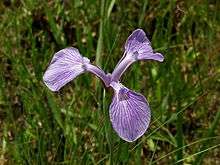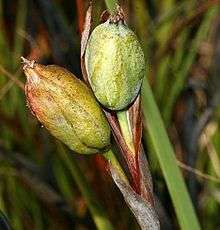Iris tridentata
| Iris tridentata | |
|---|---|
 | |
| Scientific classification | |
| Kingdom: | Plantae |
| (unranked): | Angiosperms |
| (unranked): | Monocots |
| Order: | Asparagales |
| Family: | Iridaceae |
| Subfamily: | Iridoideae |
| Tribe: | Irideae |
| Genus: | Iris |
| Subgenus: | Limniris |
| Series: | Tripetalae |
| Species: | Iris tridentata |
| Binomial name | |
| Iris tridentata Pursh | |
| Synonyms | |
| |
Iris tridentata is a species in the genus Iris, it is also in the subgenus of Limniris and in the 'Iris series Tripetalae. It is a rhizomatous perennial.
It has the common name of Savannah Iris[2][3][4][5][6][7][8][9] or Bay Blue-flag Iris[6][10] Note, normally Iris versicolor is commonly called 'Blue flag iris'.[10][11] and occasionally Purple Flag.[12][13] Note, Iris germanica can also be called 'Purple Flag'.
It was originally called Iris tripetala by Thomas Walter in Flor. Cab. 66. in 1788. But the specific name tripetala had to be later rejected because it had already been used by Carl Linnaeus the Younger (son of Carl Linnaeus), for what later became Moraea tripetala (L.f.) Ker Gawler.[14]
'Tridentata' means three toothed iris in Latin.[15][16]
It was first published by Pursh in 'Flora Americae Septentrionalis' (translated as Systematic Arrangement and Description of the Plants of North America) on December 1813.[17]
As most irises are diploid, having two sets of chromosomes. This can be used to identify hybrids and classification of groupings.[18] It has a chromosome count: 2n=40.[3][19][20]
It is mentioned in 'A Fifth Checklist of Tennessee Vascular Plants'.[21]
Specimens are found in Florida Museum of Natural History.[6]
It is hardy to USDA Zone 5 to 8.[2][15]
It can grow in part-shaded places,[3] with acidic soils within gardens.[22] It will grow well, when planted in a butterfly garden.[13] It can also be classed as a bog garden plant, tolerating waterside edges.[2] During the winter period, depending on the severity of the winter, the leaves generally die, to re-grow next spring. When, new plants are planted, they take a year to settle in before flowering.[2] They can be grown in large pots or containers.[2] It is rare in cultivation in the UK,[23] as it is not very hardy.[24]
Description

Iris tridentata is unique among other irises, the flowers and growth habit is dissimilar to any other iris,[2] including the other two species within Iris series Tripetalae.[3]
The iris rhizome has been noted by W. R. Dykes (1913) as “almost stoloniferous,” by J. K. Small (1933), “the cord-like rootstocks are peculiar,” and by R. K. Godfrey and J. W. Wooton (1979), “clothed with coarse, strongly many-ribbed, brown, overlapping scales”.[3]
The slender rhizomes,[15] branch very easily creating large spreading colonies.[4][25] They are generally 1.5–2 cm in diameter with coarse, strongly ribbed, brown, scale-like leaves.[3] It roots at the nodes of the rhizomes.[4][25]
Iris grows to a height of between 30–70 cm tall,[5][15][22][24][25] (12" to 28").[2] The flowering stalk (stem) is generally taller than the surrounding leaves,[4] and 3–7 cm in diameter.[3] It has between 1 and 3 branches (normally one) holding one flower.[15][24][25]
In late spring, the new bright green leaves will grow and lengthen,[2][3][4][25] from the base of the plant[3][4] and grow to between 30–50 cm long.[15][25] (a foot to 18in).[16] They occasionally have red-brown edge,[3][25] upright (or sword-like) in shape, and 1.5 to 2.3 cm wide.[3][15][25] The leaves can encircle the stem of the plant.[16]
It has fragrant flowers in spring,[2][22] between May and June.[2][3][15][26] It comes in a range of blue shades. From violet,[2][15][23] violet-blue,[2][3][16][25] purple,[13] purple-blue[4][15] and blue.[5] They also have a darker purple veining and a yellow-white signal.[3][4][15][25] Very similar to Iris virginica,[13] it has very small bristle free, standards (about 1.5 cm long).[3][15][22] The sepals are about 7–8 cm (2.8–3.1 in) long.[13][25] The perianth tube is about 2–2.5 cm long.[3]
It has a seed capsule (after flowering) between August and October.[3][26] The capsule is globule to oblong shaped, (about 2.5–4 × 2 cm).[3][15] Inside are dark red-brown semi-circular, flattened seeds (about 6-8mm wide).[3][15] The seeds are very similar to Louisiana irises or Iris virginica.[2]
Native
Iris tridentata is found in Southeastern United States, in regions that have rivers that drain into the Gulf of Mexico.[2][15] More specifically; Florida[24][26][27][28] (Escambia County[13] Palm Beach [29] Duvall County[22] and Wakulla County[22]), North Carolina,[4][10] South Carolina (Clarksville, Calhoun County[5] and Carolina Bays[30]), Tennessee,[4][24] Georgia[10] (Appling County), Alabama and Louisiana (Johnson Bayou[12]).[3][25]
It prefers the habitat of wetlands,[30] wet savannahs,[26] damp meadows,[15][25] damp ditches,[12][15] pine flatwoods, swamps (in Tennessee),[4] bogs (in Florida),[22] and beside the margins of pineland pools[10] or small ponds and streams.[5][25]
References
- ↑ "Iris tridentata Pursh is an accepted name". theplantlist.org. 23 March 2012. Retrieved 7 November 2014.
- 1 2 3 4 5 6 7 8 9 10 11 12 13 14 Kramb, D. (20 April 2006). "Iris tridentata". signa.org (Species Iris Group of North America). Retrieved 16 November 2014.
- 1 2 3 4 5 6 7 8 9 10 11 12 13 14 15 16 17 18 19 20 "FNA Vol. 26 Page 373, 375, 380". efloras.org. Retrieved 16 November 2014.
- 1 2 3 4 5 6 7 8 9 10 11 "Iris tridentata: Savannah Iris". fs.fed.us. Retrieved 16 November 2014.
- 1 2 3 4 5 "Savannah Iris – south carolina". florida.plantatlas.usf.edu. Retrieved 16 November 2014.
- 1 2 3 "Iris (Iridaceae modern phylogenetic circumscription) - index of taxa". flmnh.ufl.edu. Retrieved 16 November 2014.
- ↑ "Savanna iris". explorer.natureserve.org. Retrieved 16 November 2014.
- ↑ "Iris tridentata Pursh". plants.usda.gov. Retrieved 16 November 2014.
- ↑ Tina M. Samuels Georgia Native Plant Guide&pg=PA88 or8aLEAqHiIC, p. 88, at Google Books
- 1 2 3 4 5 "Iris tridentata". namethatplant.net. Retrieved 16 November 2014.
- ↑ Cole, Carl W. (28 September 2013). "Carolina Bay Field Trip". coastalmasternaturalists.org. Retrieved 16 November 2014.
- 1 2 3 Mary A. Hood The Strangler Fig and Other Tales: Field Notes of a Conservationist &pg=PA167 PzV6A_xp_hgC , p. 167, at Google Books
- 1 2 3 4 5 6 "IRIDACEAE (Iris) - Wildflowers of the Escambia". wildflowers.jdcc.edu. Retrieved 16 November 2014.
- ↑ "(SPEC) Iris tridentata Pursh.". wiki.irises.org American Iris Society. Retrieved 16 November 2014.
- 1 2 3 4 5 6 7 8 9 10 11 12 13 14 15 16 17 "Iris tridentata Prush. (Three toothed iris)". facstaff.hsc.unt.edu. Retrieved 16 November 2014.
- 1 2 3 4 Robert Sweet and Edwin Dalton SmithThe British flower garden: containing coloured figures & descriptions of the need more at Google Books
- ↑ "Iridaceae Iris tridentata Pursh". ipni.org. Retrieved 16 November 2014.
- ↑ Austin, Claire. "Irises A Garden Encyclopedia" (PDF). worldtracker.org. pp. 274–275. Retrieved 29 October 2014.
- ↑ Goldblatt, P,; Takei, M. (1997). "Chromosome cytology of Iridaceae: Patterns of variation, determination of ancestral base numbers, and modes of karyotype change". Ann Missouri Bot Gard.
- ↑ Henderson, Norlan C. "Iris tridentata Pursh". intermountainbiota.org. Retrieved 16 November 2014.
- ↑ Fifth Checklist of Tennessee Vascular Plants&pg=PA16 xh-NE2dRdNsC , p. 16, at Google Books
- 1 2 3 4 5 6 7 Ward, Daniel B. (August 2011). "KEYS TO THE FLORA OF FLORIDA - 28, IRIS (IRIDACEAE)" (PDF). Phytologia (Department of Botany, University of Florida). Retrieved 17 November 2014.
- 1 2 Stebbings, Geoff (1997). The Gardener's Guide to Growing Irises. Newton Abbot: David and Charles. p. 48. ISBN 0715305395.
- 1 2 3 4 5 Cassidy, George E.; Linnegar, Sidney (1987). Growing Irises (Revised ed.). Bromley: Christopher Helm. p. 146. ISBN 0-88192-089-4.
- 1 2 3 4 5 6 7 8 9 10 11 12 13 14 "The Planzengattung Iris". orchideenkultur.net. Retrieved 16 November 2014.
- 1 2 3 4 Blanco White, Anne (Autumn 2009). "The Group for Beardless Irises, Issue No 6" (PDF). beardlessiris.org. p. 12. Retrieved 19 November 2014.
- ↑ "Panhandle Wildflowers". spacecoastwildflowers.com. 22 May 2012. Retrieved 16 November 2014.
- ↑ Daniel F. Austin Ethnobotany&pg=PA68 7qgPCEiI4WMC, p. 68, at Google Books
- ↑ "Plant List". palmbeachpreservation.org. Retrieved 16 November 2014.
- 1 2 Cheesman, A. W. (2014). "Forms of organic phosphorus in wetland soils" (PDF). Supplement of Biogeosciences Discuss. Retrieved 16 November 2014.
Other sources
- Albert E. Radford, Harry E. Ahles, C. Ritchie Bell, Manual of the Vascular Flora of the Carolinas, 1964, The University of North Carolina Press.
External links
 Media related to Iris tridentata at Wikimedia Commons
Media related to Iris tridentata at Wikimedia Commons- Image of Tridentata
 Data related to Iris tridentata at Wikispecies
Data related to Iris tridentata at Wikispecies